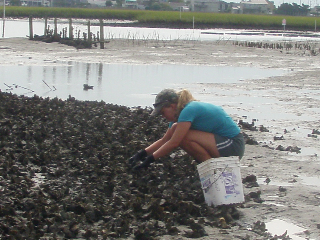A nice article by Mark Derewicz (excerpted below) about UNC PhD student Rachel Gitman and her work to understand the implications of “armoring” our shorelines to reduce coastal erosion. Sea level is rising in North Carolina at a rate of about 2-3 mm per year. Combined in some locations with boat traffic, sea level rise is causing the rapid erosion of coastal wetlands (and people backyards!).
Rachel is measuring how different types of shoreline protection affect the ecosystem functioning of marshes. For example, she is looking at the ability of fish, birds and invertebrates to use marshes with various types of armoring. She is also interested in how such shoreline engineering affects other habitats such as the oyster reefs and seagrass beds that are seaward of the sills and bulkheads. See the slideshow of some of the shoreline structures Rachel is working with below:
[cincopa AEMApm6Qh4Xr]
In 2010, Rachel Gittman spent her summer days knee-deep in the cool waters of North Carolina’s channels and sounds, enjoying the views, the sea breezes, and the sun, while other graduate students toiled in dimly lit labs. She wasn’t on vacation. She was checking North Carolina’s fish habitats. We humans had built rocky walls around some salt marshes that many young fish call home. Gittman was curious to see if fish could wriggle their way through or over the man-made barriers. If not, we humans might have fewer fishes to fry.
For centuries, North Carolina’s tidal salt marshes have acted as buffers from storms and erosion while serving as habitats for fish and crustaceans. But the coast is an ever-changing place. For instance, rising sea levels have caused some salt marshes to slowly migrate inland. That’s not a problem in unpopulated areas. But when marshes creep toward valuable waterfront property, residents get antsy. Some homeowners have built walls on the edges of their properties to keep the marshes and erosion at bay lest their backyards turn into wetlands or their homes fall into the sea.
Read the whole article by here at Endeavors

Leave a Reply